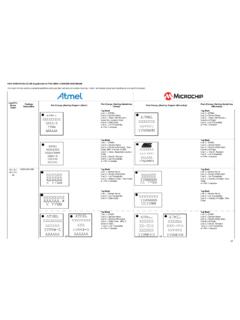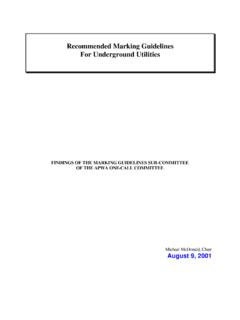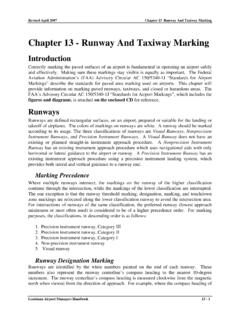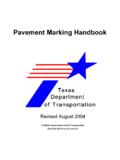Transcription of Marking & Labeling Requirements of the IMDG Code
1 Jan 2013 Jerry Green Consulting, Inc. Section 8: Marking & Labeling IMO/IMDG Vessel Page 1 Marking & Labeling Requirements of the IMDG Code Markings and Labeling are the subjects of Chapter of Volume 1 of the IMDG Code. All markings and labels must be visible, legible, and durable. They must be able to withstand three months immersion in the sea if there is any possibility that the package could survive that long. Labeling Requirements of the IMDG Code As is the case with the other major shipping regulations, the IMDG Code requires Labeling of all primary and subsidiary hazards. The Dangerous Goods List does not have a dedicated Labeling column, so the reader must look at Columns 3 and 4 and react to whatever risks are shown there. Basic Markings Normally packagings holding dangerous goods are marked with: Proper Shipping Name Identification Number Technical Name if required by Special Provision 274 Additional Markings These markings include: The Marine Pollutant Marking if the material is a marine pollutant.
2 (Exceptions exist for small packages) Limited Quantity Mark when the quantity meets the criteria in Column 7a of the Dangerous Goods List. Orientation Arrows to be placed on two opposite sides of combination packagings containing liquid dangerous goods. Jan 2013 Jerry Green Consulting, Inc. Section 8: Marking & Labeling IMO/IMDG Vessel Page 2 Marking of Cargo Transport Units Generally, the only markings that could appear on the outside of a CTU are: UN Number Display if the contents of the CTU consist of one UN Number and the gross weight of the material exceeds 4000 kg. Marine Pollutant Marking if a marine pollutant is present in the CTU. The Limited Quantity mark (Reference IMDG ) if the contents of the unit consist solely of limited quantities. All of these markings are to be applied to each side and each end of the unit. The Marine Pollutant Marking of the 34th Amendment The current marine pollutant Marking , established in the 34th amendment, is pictured below: Packaging containing marine pollutants must bear this environmentally hazardous substance mark with the exception of single packagings and combination packagings where such single packagings or inner packagings of combination packagings have a net quantity of less than 5L for liquids or 5kg for solids.
3 Jan 2013 Jerry Green Consulting, Inc. Section 8: Marking & Labeling IMO/IMDG Vessel Page 3 Limited Quantities Markings The 36th Edition of the IMDG Code references the Limited Quantity mark bearing the appropriate UN identification number to the new Limited Quantity marks pictured below: The mark with the letter "Y" in the center when packaged in conformity with the ICAO Technical Instructions is acceptable, even when transported by vessel When in limited quantities, class 8 packing group II liquids in glass or similar inners also need rigid intermediate packaging. Other substances in limited quantities in fragile inners will need suitable intermediate packaging when in shrink or stretch wrapped trays. Limited quantities of packages containing marine pollutants do not need to be marked with the marine pollutant mark. Marking & Labeling of Overpacks IMDG Code Volume 1 Chapter The HMR and the IMDG Code permit overpacking of hazardous materials.
4 If multiple hazardous materials are placed in the same overpack, compatibility must be ensured. Marks and labels must be reproduced on the outside of the overpack if the overpack obscures the marks and labels that are on the packages themselves. Overpack certification is required if an overpack obscures UN specification package markings. This certification is accomplished when the word OVERPACK is marked on the outside of the overpack. OVERPACK Jan 2013 Jerry Green Consulting, Inc. Section 8: Marking & Labeling IMO/IMDG Vessel Page 4 Marking & Placarding of Cargo Transport Units These rules are found in Volume 1, Chapter The chapter is conservative, literally requiring that most CTUs bear placards. Primary and subsidiary risks are placarded in the IMDG Code. The unit will be placarded on each side and each end. The only exceptions revolve principally around limited quantities. Placards must be able to withstand three months immersion in the sea.
5 CTU Marking These markings will principally consist of the display of the UN Number on large loads in excess of 4000 kg gross weight. These markings must be placed on each side and each end and are illustrated below: Jan 2013 Jerry Green Consulting, Inc. Section 8: Marking & Labeling IMO/IMDG Vessel Page 5 Another possible CTU Marking is the Marine Pollutant Marking which again must be placed on each side and each end of the unit. The final possible CTU Marking is the Limited Quantity Marking which must appear on each side and each end of the unit, when dangerous goods in only limited quantities are present.









